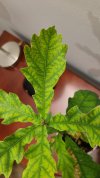I'm asking here because I know you guys have extensive knowledge in starting trees indoors. I have been reading these forums for a while already and found the knowledge shared here very valuable.
I started many varieties of trees, mostly nut trees (oaks, hickories, walnut, horsechestnut) and followed a lot of the advice I read in this ver complete thread. Here are some information on my setup:
Containers: RootMaker 18 propagation trays (not the express individual ones, though)
Soil: Promix BX
Nutrients: Osmocote Plus mixed in
Light: LED grow lights (the ones weed growers use) in a 2x4 grow tent, synchronized with sunrise / sunset
Water: rainwater collected from the gutters, exclusively
Air: ~76-80 F, 45-60% humidity, fan one hour ON / one hour OFF
Sown 3-4 weeks ago
Here are pictures of the discoloration (those are english oaks but I also see it on other oaks):


The one on the left is an english oak I started a month before the others to test my setup. It's more evident on that one but the same pattern is starting to emerge on the new ones. Do you have any idea what it could be? It would be very unfortunate if I missed one small thing and it stunts or kills them.
Thank you!
I started many varieties of trees, mostly nut trees (oaks, hickories, walnut, horsechestnut) and followed a lot of the advice I read in this ver complete thread. Here are some information on my setup:
Containers: RootMaker 18 propagation trays (not the express individual ones, though)
Soil: Promix BX
Nutrients: Osmocote Plus mixed in
Light: LED grow lights (the ones weed growers use) in a 2x4 grow tent, synchronized with sunrise / sunset
Water: rainwater collected from the gutters, exclusively
Air: ~76-80 F, 45-60% humidity, fan one hour ON / one hour OFF
Sown 3-4 weeks ago
Here are pictures of the discoloration (those are english oaks but I also see it on other oaks):


The one on the left is an english oak I started a month before the others to test my setup. It's more evident on that one but the same pattern is starting to emerge on the new ones. Do you have any idea what it could be? It would be very unfortunate if I missed one small thing and it stunts or kills them.
Thank you!
